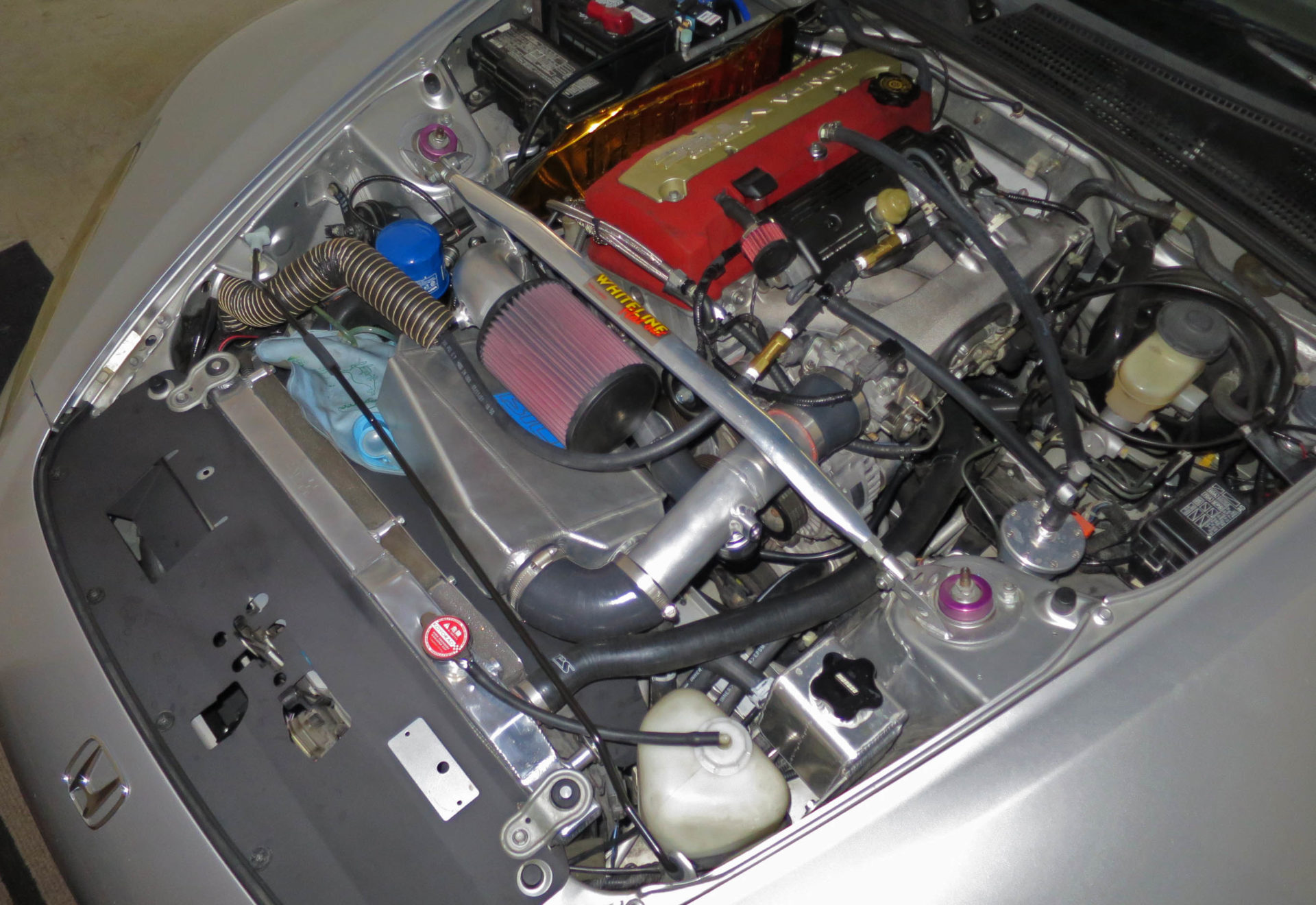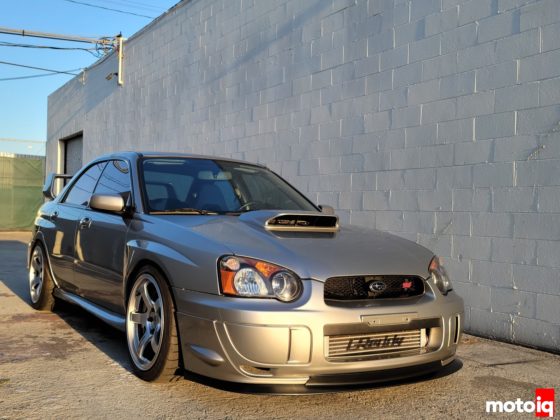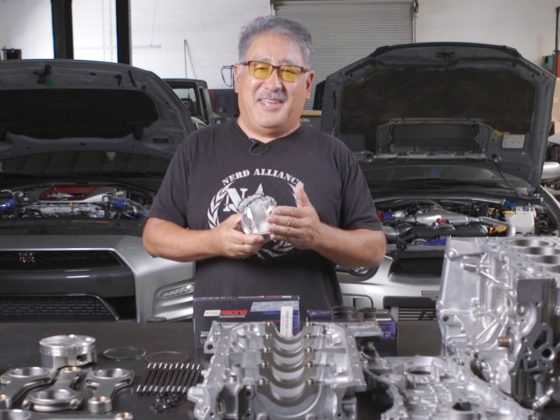 One of the turbo coolant lines was right up against the valve cover, so I used some more DEI exhaust wrap. I also used a zip-tie to keep the routing of the two turbo coolant lines a little cleaner.
One of the turbo coolant lines was right up against the valve cover, so I used some more DEI exhaust wrap. I also used a zip-tie to keep the routing of the two turbo coolant lines a little cleaner.
 To supply coolant to the turbo, I used the coolant lines that were going to the throttle body. So now the throttle body is bypassed in the coolant loop. Coolant is only needed to warm the throttle body in cold weather which is not an issue in SoCal. The coolant lines are from ATP Turbo and I got some adapters from Racetronix to go from AN to hose barb.
To supply coolant to the turbo, I used the coolant lines that were going to the throttle body. So now the throttle body is bypassed in the coolant loop. Coolant is only needed to warm the throttle body in cold weather which is not an issue in SoCal. The coolant lines are from ATP Turbo and I got some adapters from Racetronix to go from AN to hose barb.
 The prevent rubbing of the coolant lines and fittings against each other, I chopped up some EPDM coolant hose to use as sleeves. Pretty? No. Effective? Yes. Like my engine mount wrap job.
The prevent rubbing of the coolant lines and fittings against each other, I chopped up some EPDM coolant hose to use as sleeves. Pretty? No. Effective? Yes. Like my engine mount wrap job.
 The coolant from the turbo feeds back into this coolant line here that I had to bend a bit. The black T-fitting and hose just below are the boost/vacuum reference for the Turbosmart BOV.
The coolant from the turbo feeds back into this coolant line here that I had to bend a bit. The black T-fitting and hose just below are the boost/vacuum reference for the Turbosmart BOV.
 I used the Mity Vac to test when the Turbosmart Plumb Back Uni-38mm BOV would open. I want it open while the engine was in vacuum as I’m running a recirculated setup, so I ended up cutting off a good chunk of the spring similar to Dan on Project Evo X. Here you can see with just a bit of vacuum, the valve is now cracked open. I have heard of people saying the Garrett G25-660 whistles a lot. I have no such issues. My theory is they are using BOVs that stay closed while the engine is in vacuum. Because the turbo wants to push so much air even at low engine loads and the air has nowhere to go, that air ends up being forced through the ported shroud of the compressor housing and making the high-frequency whistling noise.
I used the Mity Vac to test when the Turbosmart Plumb Back Uni-38mm BOV would open. I want it open while the engine was in vacuum as I’m running a recirculated setup, so I ended up cutting off a good chunk of the spring similar to Dan on Project Evo X. Here you can see with just a bit of vacuum, the valve is now cracked open. I have heard of people saying the Garrett G25-660 whistles a lot. I have no such issues. My theory is they are using BOVs that stay closed while the engine is in vacuum. Because the turbo wants to push so much air even at low engine loads and the air has nowhere to go, that air ends up being forced through the ported shroud of the compressor housing and making the high-frequency whistling noise.




14 comments
Hey, if it’s not too late or too much of a pain in the ass to remove the oil lines with the heat sleeve on them, you may want to pull them off and get some of the adhesive lined heat shrink to put over the end of the sleeve. Keeps the fiberglass insulation from fraying/getting wet. Awesome build so far, cant wait to see it running!
I have super limited wrench time right now, so it has to go 100% to getting this car done. Good advice though!
Such a cool and detailed project. The packaging does not look fun at all. One has to wonder if a centrifugal supercharger would make more sense? e.g. something procharger or rotrex based. good high RPM power, less heat issues in engine bay, maybe better overall packaging?
Have you read the first 32 parts before commenting on this article, part 33?
A supercharger setup won’t do 320 torque crank at 3250rpm 🙂 I think my setup will do it on 91 octane. That’s the target at least! Double what a stock S2k will do and hold that torque flat to redline for 500hp crank at 8200rpm. I want double the mid-range torque to make the car more fun and useable on the street.
I am just so glad to see you get this far! Kudos! Can’t wait for a dyno pull, though!
Man….. FMIC for the win buddy, I’d tear all that out and start again
Have you read the first 32 parts before commenting on this article, part 33?
If it were a track car, air to air all the way. I’m targeting max response for the street, so minimizing the IC plumbing length along with keeping the intake air temps cool even from a stop. Sitting at a stop, I can have the SPAL fan going (A/C turned on) to keep the coolant cool and basically keep the IATs at ambient even leaving from a stop. Even without the SPAL fan running, there is a lot more thermal mass with the coolant in the IC system to reduce heat soak.
My goodness that’s a lot of careful packaging. Look forwards to when you can see what it’s all capable of!
Can’t quite tell from the picture of your I/C water pump but it doesn’t look rubber mounted, if you had some way to isolate it from the chassis the noise might be significantly reduced.
There’s a better picture in the link below. It’s a rubber mount/sleeve the pump slides into. Once the engine is running, you cannot hear the pump from inside the car. Outside the car, you really have to listen for it and stand near the corner where the pump is mounted to notice it. So no more worries on pump noise! I was over-thinking things a bit there.
https://motoiq.com/project-s2000-part-30-cooling-upgrades-and-packaging-improvements/5/
I had a W2A intercooler whose core loved back by the firewall. Silly me never ran a reservoir and that thing got HOT but wasn’t prone to puking. Yours is a much better setup, and I probably read it 20 episodes ago, but do you have a hood vent or something to keep the engine heat from dumping into the core? Being in front of the heat source helps I’m sure
No more vented track hood in order to stay low key. I have the air deflector underneath the intercooler core to shield it from the warm air from the radiator. The coolant pump runs 100% of the time for the IC so it’ll cool the core anytime I’m not boosting. At the situation of sitting at a stop light, I can turn on the A/C to run the fans including the fan on the heat exchanger for the IC system. I’ve tested it where if I turn on the A/C and run the heater at full blast, it’ll pull the engine coolant temp down pretty quickly. Even below the thermostat setting for a bit before the thermostat adjusts. Though in everyday driving, that won’t be necessary as I’ll be traction limited in first gear anyway.